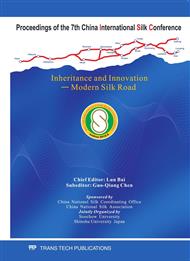p.651
p.656
p.661
p.667
p.672
p.677
p.681
p.687
p.691
Dyeing Tussah with Liquids Containing Anthocyanins and Mordant
Abstract:
In this study the natural dye Anthocyanins was extracted from red-onion skins with the ethanol solution and then the obtained dye was applied to dye tussah silk strips with four methods: direct staining, pre-mordant, together-mordant and last-mordant. The best dye-uptake of the tussah silk strips could be obtained when pH value was 4.5, temperature was 60°C and concentration of dye was 10 % with the direct staining. The different colors of dusky brown, brown, faint yellow, light green, reddish brown, cyan and green could be obtained by using chitosan and various salts of transition elements (Fe2+,Fe3+,Mg2+,Al3+,Cu2+, Mn2+ ) as mordant agents and color tones, color depth and brightness were influenced by different mordant and staining techniques. The result also showed that the silk strips were dyed poorly without any mordant and the dyed tussah silk strips had good fastness and the anti-bacterial activities.
Info:
Periodical:
Pages:
672-676
Citation:
Online since:
January 2011
Authors:
Keywords:
Price:
Сopyright:
© 2011 Trans Tech Publications Ltd. All Rights Reserved
Share:
Citation:


